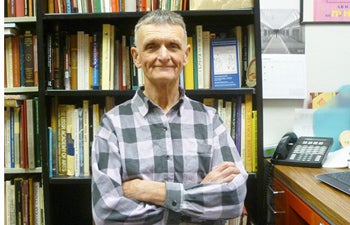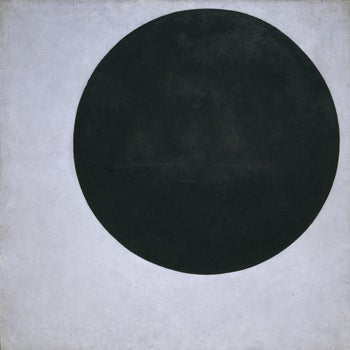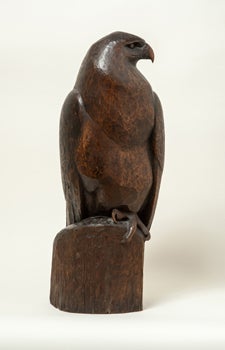Shamans and the Russian Avant-garde
White Oval is an enigmatic canvas of bright colors and intricate, abstract shapes on a pale background. Considering Wassily Kandinsky’s 1919 oil painting might leave you groping for context. Indeed, the artist himself once suggested his paintings be “listened to” as if a piece of music.
But once you learn about Kandinsky’s keen intellectual and anthropological interests, personal travel writings and fascination with shamanistic spiritual practices, context begins to materialize. Shamans, understood to be intermediaries between the human and spirit worlds, communicate with the divine through ecstatic dancing fueled by the driving rhythm of their drums. These sacred drums were elaborately adorned with hieroglyphs and illustrations to emphasize their spiritual importance.
Upon viewing White Oval side-by-side with a Siberian ethnographic artifact — a shaman drum — as part of The Russian Avant-garde, Siberia and the East exhibition opening this week, the artist’s inspiration becomes suddenly and beautifully evident.
Housed in Palazzo Strozzi in Florence, Italy, the exhibition runs from Sept. 27 to Jan. 19, 2014. It is the first international exhibition to closely examine the significance of Eurasian and Oriental influences on the radical Russian artists that contributed to the development of modern art. Neolithic stone figures, Siberian shamanism, popular Chinese prints, Japanese engravings and theosophical doctrine are some elements that inspired Russia’s avant-garde and the aesthetic approach they developed in the years before and after the 1917 Russian Revolution.

John Bowlt, professor of Slavic languages and literatures, and director of the USC Institute of Modern Russian Culture based at USC Dornsife, is co-curator of The Russian Avant-garde, Siberia and the East exhibition that opened Sept. 27 in Florence, Italy. Photo by Mark Konecny.
“The purpose of the exhibition is to show that leading modern Russian artists such as Kandinsky and Malevich produced their radical art forms by looking not only westward at Paris, Milan and Berlin — at cubism, futurism and expressionism — but also by looking to the East, which is typically forgotten or disregarded,” said John Bowlt, professor of Slavic languages and literatures and director of the USC Institute of Modern Russian Culture, based at USC Dornsife.
Bowlt is co-curator of the exhibition.
“We wanted to emphasize the collaborations between Russian artists living in Moscow or St. Petersburg and their relationship with ‘the other.’ For them, this was represented by the vastness of Siberia, the spirit of the taiga, a different sense of space and logic, and the enigma of the Orient.”
The exhibit comprises 120 paintings, sculptures, Oriental artifacts and ethnographic objects from the period of the Russian Avant-garde movement, between 1890 and 1930. In addition to works by artists such as Wassily Kandinsky, Kazimir Malevich and Pavel Filonov that are well-known in the West, the exhibit also features artists more widely celebrated in Russia, including sculptor Vasilii Vatagin.
Other co-curators include Nicoletta Misler, professor of modern Eastern European art at the Instituto Universitario Orientale in Naples, Italy; and Evgenia Petrova, deputy director for science at the State Russian Museum in St. Petersburg; along with the assistance of James Bradburne, director general of Palazzo Strozzi.

Russian artist Kazimir Malevich completed the oil painting Black Circle in 1915. Some say the circle represents a window into the night; a metaphor for the good and evil forces in World War I; or a nirvanic reduction to nothing, zero, absence. Image courtesy of the State Russian Museum, St. Petersburg.
The work of some of these artists was influenced by shamanism and the artifacts that accompanied their rituals. Other influences include Chinese and Japanese notions of perspective, Indian art, Hinduism, Buddhism and the concept of nirvana. Thus the exhibit offers viewers an array of ideas and concepts typically not discussed when talking about the abstract art of Kandinsky, for example.
“Today, in our nine to five lives, we don’t tend to think much about, say, the fourth dimension. But these Russian artists did.”
Bowlt pointed out that even Jackson Pollock in the United States was influenced by shamanism, as evidenced by his action painting.
He hopes that the exhibit exposes people to the many Russian artists that are more or less unknown outside of their country. One example is Vatagin, who was very famous in Russia during the 20th century. Though it was silenced throughout the Soviet era, it eventually came to light that Vatagin’s attraction to animals as subjects derived from a personal connection to Hinduism.

Nationally celebrated Soviet-era sculptor Vasilii Vatagin specialized in animal subjects such as this work, Eagle, carved from wood. His interest in animals stemmed from his experiences with Hinduism during early travels to India. Image courtesy of the State Russian Museum, St. Petersburg.
“We found out that he had visited Ceylon [now Sri Lanka] and India around 1913,” Bowlt said. “While there, he took part in Hindu rituals and processions, and he also took drugs. He was very much into theosophy [philosophy concerning the nature of divinity] and his diaries tell a lot about what he did there. So we’re trying to show that his beautiful animal sculptures are indebted to his Hindu experiences.”
Bowlt expounded on how he approached the curating task.
“You can’t just have a cocktail of ‘stuff’ — anyone can do that,” he said. “You have to justify the connections, explore each artist’s concept of the East or Siberia: whether they actually traveled to the East, kept a diary or wrote a memoir about their experiences, etc.
“You have to cull all that information and then find an ethnographical object that probably appealed to the artist. Of course you also have to consider what the public will go for, what’s exciting — these epithets as well as the academic base.”